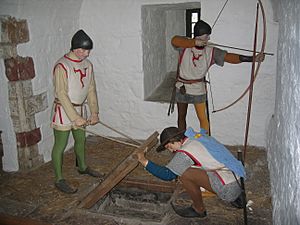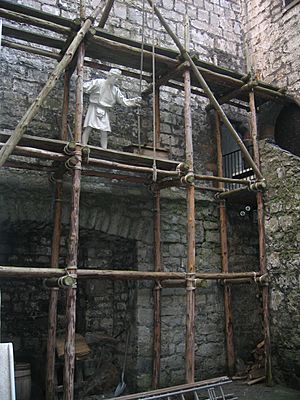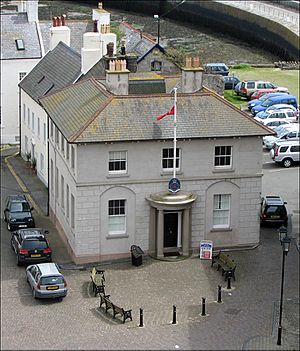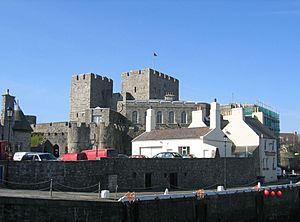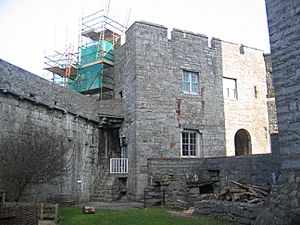Castle Rushen facts for kids
Quick facts for kids Castle Rushen |
|
|---|---|

Castle Rushen as seen from Castletown's market square.
|
|
| General information | |
| Town or city | Castletown |
| Country | Isle of Man |
| Completed | 16th century |
| Design and construction | |
| Architect | Several |
Castle Rushen (in Manx, Cashtal Rosien) is an amazing old castle in Castletown, the historic capital of the Isle of Man. It stands tall over the Market Square and the harbour. This castle is one of the best examples of medieval castles in Europe. Today, it's a popular museum and a place where kids can learn about history.
Contents
Building a Mighty Castle
It's believed that people started building Castle Rushen in the 900s. This was when the "Kings of Mann and the Isles" ruled the Isle of Man. An old wooden beam found in the castle even had the date 947 on it!
The last King of Man, Magnús Óláfsson, died at the castle in 1265. The first part of Castle Rushen was a strong, square stone tower called a keep. It was built to protect the entrance to the Silver Burn river. Over many years, from the 1200s to the 1500s, different rulers added more to the castle. Its strong limestone walls showed everyone who was in charge of the island.
How the Castle Grew Over Time
By 1313, the main tower was made even stronger with new towers on its west and south sides. In the 1300s, builders added an east tower, special gatehouses, and a strong outer wall called a curtain wall.
Exploring Castle Rushen's Defenses
The castle's first line of defense is a thick outer wall. It's about 25 feet (7.6 meters) high and 7 feet (2.1 meters) thick. Five towers are part of this wall. Later, these towers were used for things like offices, not just defense.
The main tower, or keep, has walls that are 12 feet (3.7 meters) thick at the bottom. They are still 7 feet (2.1 meters) thick at the top! Four towers sit on top of the keep. The tallest one, in the north, reaches 80 feet (24 meters) high. The other three are about 70 feet (21 meters) tall.
Clever Ways to Keep Enemies Out
To get into the main tower, you had to cross a drawbridge. Then, you faced a very strong inner gatehouse. This entrance had two heavy metal gates called portcullises. If enemies got trapped between them, defenders could drop things through "murder holes" from above!
Guardhouses were on either side of the gatehouse. These later became prison cells. Inside the gatehouse, there was even a tide mill to grind corn. The castle also had a chapel and a clock. The clock still works today! Queen Elizabeth I of England gave it to the castle in 1597.
Outside the castle, a moat (a ditch filled with water) and a sloping bank called a glacis added extra protection.
Castle Rushen's Exciting History
Battles for Control: Scots vs. English
After the Norse-Gaelic rulers, the castle was often fought over by the Scots and the English. In 1266, the Isle of Man became part of Scotland.
On May 18, 1313, the Scottish King Robert the Bruce invaded the Isle of Man. He captured the island in just five days! The only place that fought back was Castle Rushen. It was defended by Dungal MacDouall. After a three-week siege, Robert the Bruce captured the castle on June 12, 1313. This helped him protect western Scotland.
Over time, the English eventually gained control. King Edward I said the island had always belonged to the English kings.
From 1405 to 1738, the Stanley family ruled the Isle of Man. Sir John Stanley was given the title "King of Mann" in 1405. Later, in 1521, this title changed to "Lord of Mann." Today, the reigning British monarch holds this title.
Castle Rushen During the English Civil War
During the English Civil War (1642–1651), James Stanley, 7th Earl of Derby, who was the Lord of Mann, supported the King. He was known as The Great Stanley. James set up a royal court at Castle Rushen before leaving to fight in England.
In 1651, James was captured and executed. He left his wife, Countess Charlotte, in charge of the Isle of Man. Countess Charlotte was famous for defending another castle in England. She held Castle Rushen until a local rebellion and a mutiny by her own soldiers forced her to give up the castle.
Castle Rushen: More Than Just a Fortress
A Center for Government and Law
Even when it wasn't needed for defense, Castle Rushen was always busy. It was an important administrative center. In the 1700s, there was a place to make money (a mint) inside its walls. The island's southern law court still meets there today! The Manx law books were also kept safe in the castle.
In the 1500s, the "24 Keys," an early name for the Manx Parliament's lower house, met at Castle Rushen. They didn't have a permanent home until 1710. Later, they moved to a special building called The Old House of Keys in 1821. Since 1874, the House of Keys has been in Douglas, the island's capital.
From Castle to Prison
By the late 1700s, the castle started to fall apart. It was turned into a prison. Conditions for prisoners became very bad. In the late 1800s, things were so bad that a new prison was built. The modern Victoria Road Prison opened in 1891.
After losing its other uses, Castle Rushen continued as a prison. Prisoners were moved there from Peel Castle in 1780. For a long time, not enough money was spent on keeping the castle in good shape. This meant prisoners suffered from the cold and bad weather.
Inmates who were healthy had to do forced labor. They had to meet certain work goals. By the 1880s, the prison was in such a terrible state that order broke down. An inspection in 1885 recommended building a new prison.
Castle Rushen held both men and women. Children born to prisoners could live with their mothers inside the prison. Executions also took place here. The last person executed in the castle grounds was John Kewish in 1872. He was buried within the castle walls.
One famous prisoner was Bishop Thomas Wilson, who was held in 1722. He had a disagreement with the Lord of Mann about who had power over church court cases. Later, Manx democracy activists Robert Fargher and James Brown were also jailed here. They were punished for speaking out against the House of Keys and demanding public elections.
Besides criminals, Castle Rushen also held people with mental illnesses.
A Treasure for Manx National Heritage
In 1988, Manx National Heritage took over the castle to restore it. It reopened in July 1991 as a major heritage site. Castle Rushen is one of four Manx National Heritage sites in Castletown.
Today, it's a fantastic museum that tells the story of the Kings and Lords of Mann. Most rooms are open to visitors from March to October. You can see a working medieval kitchen where they prepare old-fashioned food on special days. There are also re-enactments of medieval life, which are great for kids learning about history.
Archaeological finds from the 1980s are on display. A fun activity for schools is recreating the preparations for a visit by Thomas Stanley, 2nd Earl of Derby, the King of Mann, in 1507. This was a big deal because most Kings of Mann didn't visit the island often.
Castle Rushen is part of the "Story of Mann" collection of historical sites. It's still used as an official court house sometimes.
Castle Rushen in Modern Times
You can see Castle Rushen on the back of the Manx pound £5 banknotes. The note even shows the Castle Arms pub across from the castle!
The closing ceremony for the 2011 Commonwealth Youth Games was held in Castletown's Market Square, right in front of Castle Rushen.
The castle also gives its name to Castle Rushen High School, a local secondary school.
During World War II, a navy ship called a corvette was named after the castle: HMS Rushen Castle.
The 28-mile (45 km) Millennium Way walking path starts at Castle Rushen. This path opened in 1979, celebrating 1000 years of the Manx Parliament, Tynwald.
Some people say Castle Rushen is haunted by a lady ghost who walks the drawbridge!
See Also


